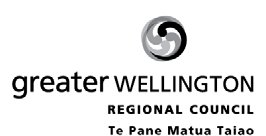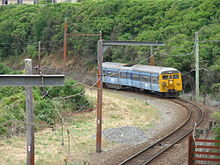 Johnsonville 15 minute peak
Johnsonville 15 minute peak
trial 20th September 2014
John Sutherland
For more information, contact the Greater Wellington Regional Council:
September 2014
www.gw.govt.nz
[Wellington Regional Council request email]
Contents
1.
Johnsonville Trial Plan
1
2.
Operational Setup
2
3.
Actual Trial
2
4.
Outcomes
2
5.
Recommendations
2
1.
Johnsonville Trial Plan
There were two objectives to the trial held on the 20 September 2014. The first was to
investigate the possibility of running 4 trains an hour; this being what is required to
achieve RS1. The second was to try and bring stability to the timetable to allow 100
percent on time performance to 5 minutes.
Three months’ worth of RTI data was used to define the run and dwell times that
reflected reality; the only issue was that the crossover below Wadestown, which isn’t
separated out of the run time, had to be collected manually. Austrics was used to
construct a timetable giving a 15 minute frequency from Johnsonville to Wellington and
at the same time building in 5minutes recovery time at Johnsonville and 7 minutes at
Wellington.
GWRC meet with TranzMetro to discuss the proposal; Ian Robson developed
modifications that built in recovery times at the crossovers for the trains going against
the peak loading. That is the down trains get priority in the morning peak and the up
trains get priority over the down train in the afternoon peak. The theory was to build
resilience into the timetable.
From the meeting and the revised timetable it was decided to run a trial simulating a
morning peak an off peak and an afternoon peak on a Saturday.
The trip times:
Morning Peak
Up Old
Up New
Down Old
Down New
21mins
22mins
21mins
22mins
21mins
22mins
21mins
22mins
24mins
23mins
21mins
22mins
22mins
28mins
21mins
22mins
24mins
28mins
21mins
22mins
24mins
28mins
21mins
22mins
24mins
28mins
21mins
22mins
24mins
28mins
21mins
22mins
24mins
28mins
21mins
22mins
21mins
28mins
21mins
22mins
REPORT JOHNSONVILLE TRIAL 20TH SEPT 2014
PAGE 1 OF 5
2.
Operational Setup
Briefing was held 5.30am, this explained that there would be 4 car sets running at
15minute intervals from Johnsonville from 6.32am until 9.00am and the out bound units
would be running with recovery time to support.
After 9.00am an off peak timetable would run until 10.47am then a simulated afternoon
peak setting priority to the Wellington to Johnsonville outbound trains.
All stops would stop for 30 seconds to simulate peak passenger loadings and a
supervisor would be on each train, timing to the second to ensure time was kept and
record all times.
3.
Actual Trial
For the trial we had showers at the start which caused the first train up to lose all of the
recovery time on the way up to Johnsonville. The train down left 2 minutes late and
even with priority was 3 minutes late into Wellington, but the next train up departed on
time. We saw the same pattern through the peak with different drivers and bad weather,
in each instance we recovered the lost time.
The off peak started on time and no issues encountered.
The afternoon peak had weather issues but the priority trains ran very well.
4.
Outcomes
The on time performance at 97.5 % in the poor conditions was excellent. The use of
recovery time on the trip with lest priority proved to add stability to the timetable. It
proved that we can run a 15minute peak time service very successfully.
5.
Recommendations
The next steps to ensure a robust process as well as timetable are run another weekend
trial hopefully on a dry day to confirm what we have learnt so far. Secondly a live trial
on Johnsonville peak on a week day.
If the above are successful have a joint plan to implement the new timetable with the
limited EMUs that we have, to establish the pattern and build patronage
6.
A brief History
The line was built in the 1880s as part of the private
Wellington and Manawatu Railway
Company line to connect
Wellington to
Longburn. Construction started in 1879, and the
first section, to Paremata, opened on 24 September 1885. The line became part of
the
North Island Main Trunk when the government bought the WMR in December
1908.
The line was used by railway workers from the Tarikaka Settlement in
Ngaio, including
early shift workers who needed to fire up steam locomotives at the Wellington depot.
Two experimental
RM class railcars were briefly used on the line as NZR sought to
develop economically viable railcar technology. T
heWestinghouse railcar was
PAGE 2 OF 5
REPORT JOHNSONVILLE TRIAL 20TH SEPT 2014
introduced in 1914 and served through to 1917. The
Thomas Transmission railcar was
introduced in 1916 and operated sporadically into the early 1920s. Both railcars
struggled on the steep grades and revealed that further advances were needed to make
railcars suitable to New Zealand's conditions.
The line became a branch when the
Tawa Flat deviation of the NIMT opened to
passengers in 1937, and was sometimes called The Hill (i
nNZR jargon). The line was
electrified at 1500
V DC overhead supply, and the first passenger train using the
new
English Electric DM/D classelectric multiple units ran on 2 July 1938. The units
normal operate as two-car motor/trailer sets, four-car sets in peak hours.
Additiona
lDM/D class units were ordered for the line in 1942 and supplied in 1946.
The line was terminated in
Johnsonville, about 100 m beyond the end of the current
line: the
State Highway 1 motorway on-ramp follows the route of the old line. Ngaio
and Khandallah stations already had crossing loops, and a third crossing loop (without
platform) at
Wadestownplus new stations at Awarua Street and Simla Crescent were
added.
Stations were added at Raroa (1940), Box Hill (1956) and Crofton Downs (1963). The
line has four stations,
Crofton Downs, Awarua Street,Box Hill, and
Raroa on a curve.
The line was reviewed in 1984, 1993 and 2006–07 to consider either closing or
upgrading it, without any significant changes being made.
Services
A half-hourly service runs daily, augmented to a 13/13/26-minute pattern at peak
periods.
The line has been passenger-only since the termination of livestock trains for an abattoir
in the Ngauranga Gorge. The livestock were originally driven on foot through
Johnsonville streets, but after protests sidings near Raroa were opened on 2 February
1958. The livestock traffic ceased about 1973, though the sidings at Raroa were not
lifted until about 1982. Because of the sharp curves on the line,
EW class electric
locomotives were used for livestock trains instead of the earlier
ED class locomotives,
which were hard on the track with their long rigid wheelbase.
Infrastructure
The line is
single track through very steep terrain rising 150 m above sea level in its
10 km length, with the highest point (152 m) at the north end of Kaka Tunnel.
The
ruling grade is 1 in 36. There are seven narrow tunnels, six bridges, three
passing
loops and three
level crossings with half-barriers, (at the Fraser Avenue crossing
barriers were installed in 2009). There is a private rail crossing to a house immediately
south of the Fraser Avenue crossing, and a pedestrian crossing to Poona Street,
REPORT JOHNSONVILLE TRIAL 20TH SEPT 2014
PAGE 3 OF 5
Khandallah south of the Rangoon Street overbridge. In 2001, an estimated
1,043
passengers use the line on a working day
.[2]
The Wellington City Council let a $1.7m tender to replace the Rangoon Street single-
lane overbridge of c1906, which crosses the Johnsonville line, with a two-lane
bridge
.[3][4] Work commenced in June 2008 and was completed by December
2008.[5]
Upgrade in 2008–2009
The
North Wellington Public Transport Study by
GWRC and
WCC considered four
options for improved public transport: enhanced rail; bus on street; conversion to
a
guided busway; and conversion to
light rail. On 16 November 2006 the GWRC Public
Transport Committe
e[6]and the WCC Strategy & Policy Committ
ee[7] accepted a "Do
Minimum" option involving retention of the line and replacement of the current
DM units with the same number of refurbished
EM/ET class (Ganz
Mavag) units
;[8] this required enlarging the tunnels and increasing platform clearances
and lengths
.[9] GWRC have since had to change to using only the new
Matangi units on
this line because of the limited braking power of EM/ET class units on the steep
grad
es[10]
GWRC envisaged (2007) that the track through the tunnels would need to be lowered by
120 mm, depending on the new units
.[11]Lengthening of passing loops and platforms
was also likely to be needed, and the estimated cost was $5 million. A programme of
preparatory work for the tunnel upgrading commenced on 7 September 2008 and was
completed in February 2009. Construction took place after 20:00 on Sunday – Thursday
nights to minimise disruption to commuters, with services being replaced by
buses
.[12] The seven tunnels were upgraded in January
2009[13] [14] during a period in
which the line was closed to all traffic
.[15] The work included:
lowering the track and widening the side clearances in the seven tunnels
lengthening the three crossing loops, allowing longer trains
upgrading platforms by lengthening them and increasing clearances
increasing clearances under two bridges: Lower a rail bridge in Ngaio Gorge (between
tunnels) and lower the level of the track under the
Raroa Station footbri
dge[16]
new power substation at Ngaio
New rolling stock
PAGE 4 OF 5
REPORT JOHNSONVILLE TRIAL 20TH SEPT 2014

A southbound DM class EMU just south of
Raroa Railway Station on the Johnsonville
Line. The last of the DM class EMUs was withdrawn from the line in February 2012.
Due to significant mechanical difficulties being experienced by Tranz Metro in keeping
the DM/D EMUs in service, several units were withdrawn from service in February
2012. Buses were added to supplement the remaining service capacity pending the
planned introduction of the FT/FP "Matangi" EMUs on 19 Marc
h 2012.[17] The first
Matangi service was the 11:02 departure from Wellington, which passed the last
English Electric service on the line at Ngaio station
.[18]
Future
The proposed redevelopment of the Johnsonville Town Centre will include
improvements to the rail and bus terminal at Johnsonville; the terminal is now referred
to as the Johnsonville Hub.
The Broderick Road overbridge immediately south of the
Johnsonville Railway
Station is to be upgraded by widening and lengthening in late 2014 to include cycle
lanes and extra road lanes over it.
[19] Provision is made for dual tracks underneath
(currently one track) into the station, as requested by the
Greater Wellington Regional
Council for future double-tracking.
[20]
REPORT JOHNSONVILLE TRIAL 20TH SEPT 2014
PAGE 5 OF 5
Document Outline

